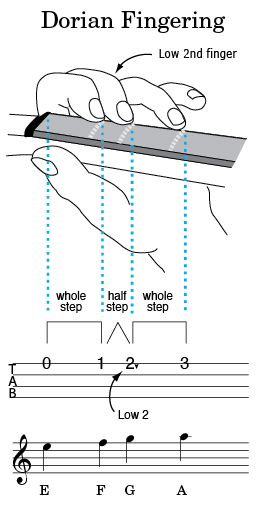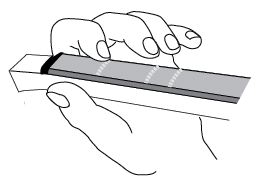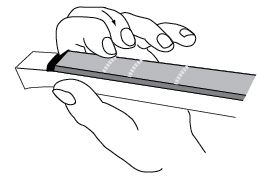
Dorian Fingering
We refer to the finger position "open, 1st finger, low 2nd, 3rd finger" as Dorian position, Dorian fingering or "low 2nd finger,"
This position produces the first four notes of the Dorian Scale: open string, whole step, half step, whole step.
Common challenges for those new to Dorian fingering.
Beginning fiddlers and violinists usually learn the Major fingering before attempting the other basic fingerings: Dorian, Phrygian and Lydian.
Beginners may spend weeks or months practicing the major scale before trying any other fingering, thus students often attempt to apply major fingering hand foundation to other hand positions. As you'll see, this is problematic.

If you start with your 2nd finger positioned as shown (in a shape for appropriately for major fingering) you'll probably have trouble placing your 2nd finger into a "low 2nd" position. The solution lies in preparing your hand for Dorian, by bringing the middle knuckle of your 2nd finger back along side the middle knuckle of your 1st finger.
While you're new to Dorian fingering, carefully prepare your hand position each time you attempt it. As always:
• Keep your hand pronated
• Play on the radial side of your fingers
• Hold your wrist straight, or slightly extended in toward the body of the violin, but not so far that it touches the body.
• do NOT bend your wrist to either side (this is called a deviation.) When you open your hand your fingers should point straight up. If they do, you are not in a deviated position.
Practice alternating between the "prepared position" and the actual fingering. Here's how.
Preparing for Dorian fingering by align the middle knuckles of your 1st and 2nd fingers.
Position the knuckle of your 2nd finger along side the middle knuckle of your 1st finger, as shown below.

Practice tapping the tip of your 2nd finger down into the low 2nd position. Tap and release for a minute or so.
If your hand is relaxed and positioned properly, you'll feel the side of your 1st and 2nd finger sliding lightly against each other. You'll also feel the pad of your second finger slide lightly along the nail of your index finger. (The movement of your 2nd finger shouldn't effect the position of your wrist or index finger, so watch carefully and notice the sensation, keeping your hand "quiet" and still.
Be mindful of your overall effort. Make sure you don't squeeze the neck between your thumb and the side of your index finger. And always use a minimum amount of pressure to touch the string down.
Common Problems
Here's a list of problems that often occur when people attempt Dorian fingering starting with the middle knuckle of the 2nd finger too far forward:
• The 2nd finger may land too high, producing a sharp (out of tune) sound.
• Attempts at lowering the tip of the 2nd finger may cause the entire 2nd finger to over arch, needless flexed and over arched, with the tip pointing back toward the palm. This may cause its nail to rock forward onto the string.
• The finger may slide into place, rather than dropping directly.
• The adjacent sides of the 1st and 2nd fingers may to separate and spread awkwardly apart. This usually occurs when the hand is tense ... or if you use interossei muscles instead of flexors and extensors. Avoid using the dorsal interossei muscles. These abduct (or spread) fingers away from the middle finger. This is a very tiring movement. Use interossei muscles only when flexors and extensors can't do the job.
Music Lessons • TheoreticallyCorrect.com homepage
All content copyright
© Singingwood Music 2007